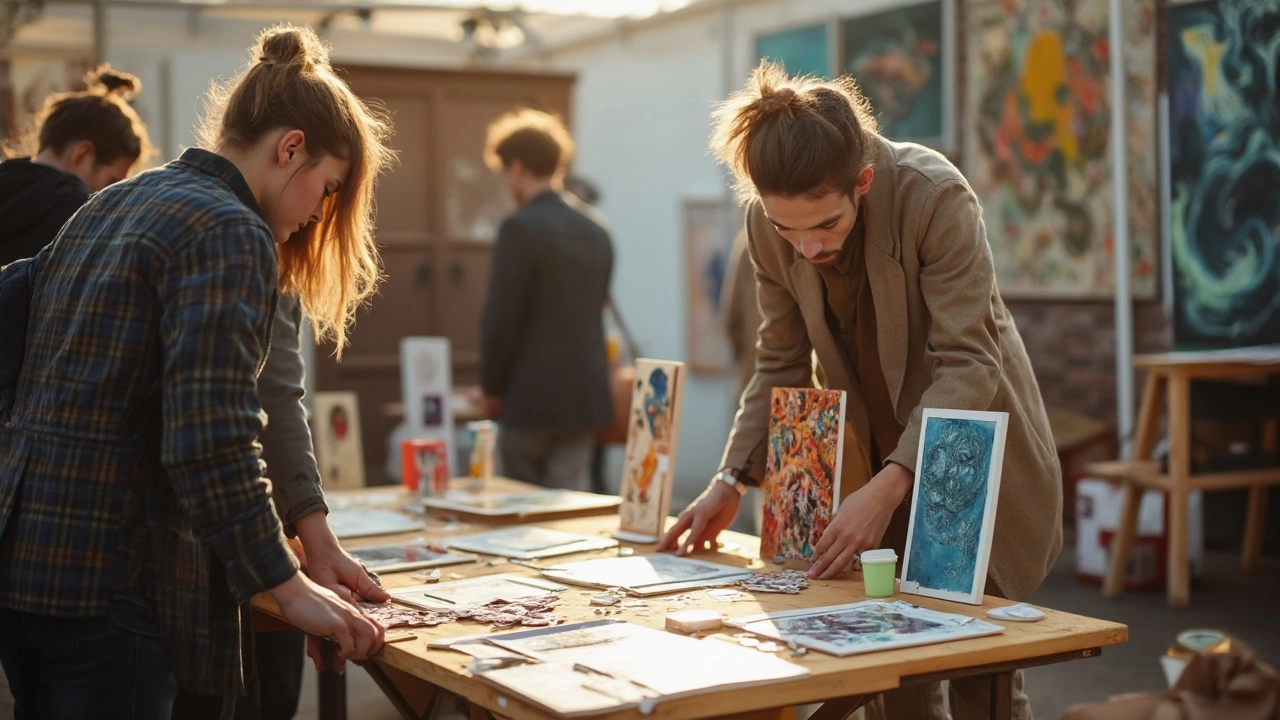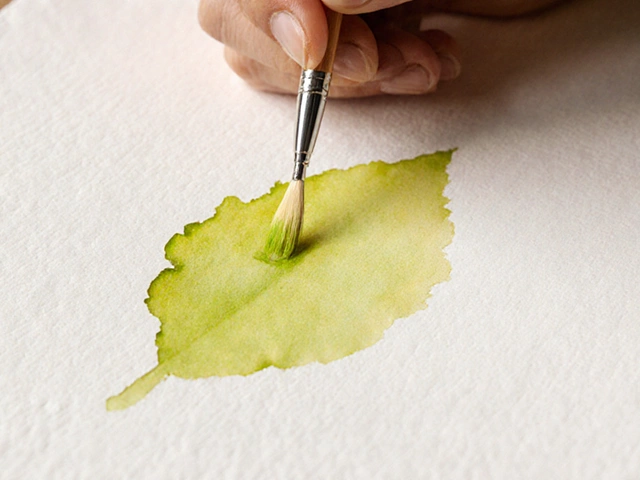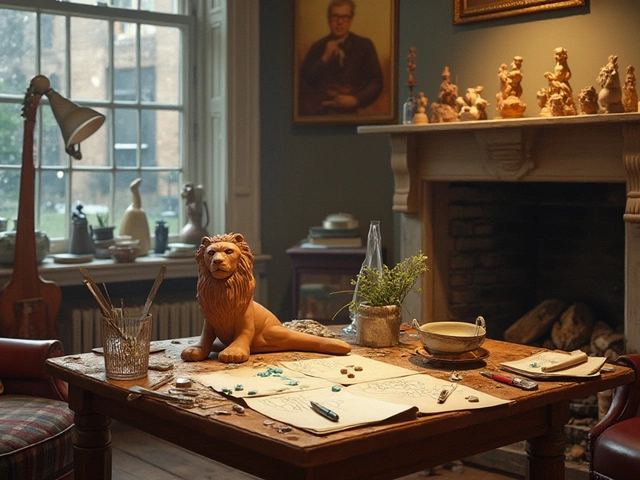Putting your art up for sale at an exhibition isn’t just about hanging it on a wall and hoping for the best. You’ve probably seen artists walk away with red dots on every piece, while others barely get a second glance. There’s a method to standing out, and it starts way before the doors open.
Don’t just sign up for any show. Look for exhibitions that actually fit your style and budget. Some shows charge high fees or target buyers who aren’t looking for your type of work. It pays to do a bit of research—check who’s buying, what’s sold in the past, and the crowd the event attracts. This step alone can save you weeks of wasted effort and a pile of cash.
Once you know you’re in the right place, the way you present your art will make or break your chances. Pricing needs to feel right for the space. If it’s a casual local show, don’t slap on gallery prices. Mix up your display: pro tip, eye-level pieces with great lighting nearly always get more attention. Got a story behind your artwork? That sells faster than a plain label.
- Choosing the Right Exhibition
- Setting Up Your Space for Maximum Impact
- Building Real Connections with Visitors
- Sealing the Deal and Following Up
Choosing the Right Exhibition
Picking the right exhibition makes a huge difference when you’re trying to sell art. Not every art exhibition is going to put your work in front of serious buyers or the right crowd. You want your art where it’s likely to find fans, not just people killing time before dinner.
Start with some simple research. Look at shows near you, check their websites and social channels, and see which ones have a vibe that matches your work. Pay attention to what’s sold at past events—most exhibitions and galleries will post this info, or you can ask the organizers. If last year’s event featured only digital art but you’re painting landscapes, keep looking.
Some shows charge fees to exhibit. Smaller community shows might cost under $50, while bigger city events can go up to several hundred bucks just for a spot. Be real about whether your sales will actually cover those costs. If this is your first show, it’s smart to start smaller, where you can meet buyers face-to-face, instead of dropping a chunk of change on something huge and impersonal.
Here’s a quick way to check if a show is worth it:
- Look at the show’s history—did people actually sell art there last year?
- Who comes to the show? Get a scoop from other artists or past attendees.
- Is the crowd likely to spend money, or just browsing?
- Is the theme a good fit? (Don’t try to sell street art at a country craft fair.)
- What’s the cost to exhibit, and are there any hidden fees? (Installation, insurance, commissions, etc.)
For perspective, a big US study in 2023 found that 70% of emerging artists who sold at least one piece had researched or visited an exhibition before applying to show there. So don’t skip this step—it saves you headaches and boosts your odds of real sales.
If you’re stuck choosing between two shows, pick the one that lets you talk to visitors. Personal interaction lifts your chances to sell art—that’s something online sales can’t really match. The best fit isn’t always the fanciest place, but the one with a crowd who digs your stuff.
Setting Up Your Space for Maximum Impact
The way you set up your spot at an art exhibition can either pull people in or have them walking right by. It’s not just about what’s on display, but how you use the space. Think of your area as your own mini-gallery, even if you’ve only got a table or a few feet of wall.
Start by making your art eye-catching—literally. Hang your best pieces at eye level. There’s plenty of data pointing to increased sales of eye-level art, simply because people are more likely to stop and look. Don’t just line everything up; play around with heights if you’re using tables, and use small stands or easels to give your setup more dimension.
Lighting is a game changer. Broken or harsh lighting can make colors look dull or even unflattering. If the exhibition allows, bring your own clip-on LED lights—they’re cheap and easy to use. Good lighting can really make your art sales pop, especially in venues where overhead lights aren’t cutting it.
Don’t crowd your space. Too much art jammed together just overwhelms people, and nothing gets noticed. Leave enough blanks so each piece gets its moment. It helps to add clear labels showing the title, price, and a short story or fact about each piece. People are far more likely to buy when something feels personal or relatable.
Here’s a breakdown of simple but effective ways to set up for maximum impact:
- Use neutral tablecloths or backdrops so the focus stays on your art.
- Put your name and contact info in a clear spot—don’t make anyone hunt for it.
- Keep a small, organized space for business cards or a portfolio of past works.
- Bring packaging materials in case someone wants to take your art home right away. Simple cardboard corners or bubble wrap go a long way.
- If selling prints or smaller items, use a rack or basket to keep them tidy and easy to browse.
For folks who love numbers, check this out: a 2023 survey by ArtFinder showed that using better lighting and clear signage increased booth visits by up to 35% at group shows.
| Booth Feature | Possible Sales Boost |
|---|---|
| Good LED Lighting | +20% |
| Clear Labels & Stories | +15% |
| Uncluttered Layout | +18% |
Making these changes doesn’t cost much but can help you actually sell art rather than just show it off. The best part? You don’t have to be a designer—just pay attention, keep it tidy, and treat your booth like your personal brand billboard.

Building Real Connections with Visitors
Putting up your art isn’t the finish line—what really matters is how you connect with people who walk through the door. Most buyers don’t just buy the art; they want to buy the story, the process, and even a piece of your journey. If you stand back and look unapproachable, you miss all of that.
Start simple. Greet visitors with a smile and be ready to give a quick, genuine answer about each piece. Think less ‘museum guide’ and more like you’re talking to a friend about your project. A lot of people feel awkward asking the artist about a sell art price, so make it easy for them by casually mentioning your work’s background and your favorite piece.
- Ask open questions. A simple “What drew you to this painting?” makes people feel engaged.
- Listen more than you talk. If someone shares their thoughts, respond with interest, not just to push a art sales pitch.
- Share a short story behind a piece. Buyers often mention later how a little behind-the-scenes info tipped them into making a purchase.
- Have business cards or an easy-follow social media handle ready. Most folks want to check out your stuff later—even if they don’t buy right away.
It helps to remember: nearly 60% of art buyers meet the artist before making a purchase, according to a 2023 Art Basel market report. This stat isn’t just trivia—it proves how important these connections are for anyone trying to sell art at an art exhibition.
Last thing—don’t just hover near your work. Walk around, chat with people browsing other booths, and you’ll find that building a network (and some new friends) often leads to more sales in the long run.
Sealing the Deal and Following Up
Nailing a sale at an exhibition takes some real-world skills. Don’t just cross your fingers—help buyers say yes. When someone lingers near your work, start a conversation. Don't launch into a pitch, just ask what caught their eye or share a quick story about the piece. People buy art because it makes them feel something, not because they got a hard sell.
If someone seems interested, make sure they know what comes next. Is your payment process simple? Got a card reader ready? Nobody carries cash like it’s 1995. Offering POS or QR code payments works wonders. Around 71% of buyers at pop-up shows, according to Art Basel’s 2023 Market Report, prefer digital or card payments, so make it easy for them.
Clear info is huge. Display prices. If a piece is available in different sizes or as prints, note that. Some folks won’t ask—they’ll just wander off. Have a price list and business cards front and center, and keep packaging handy for impulse buyers who want to walk out with your art the same day.
- Have a clear return or hold policy, especially for people hesitating on big buys.
- Offer to ship larger works if buyers can’t take them right away.
- Always provide a simple, friendly receipt—paper or digital—so buyers feel looked after.
Now, the gold: following up. If someone can’t decide, get their contact. A quick sign-up for your newsletter or Instagram is great. After the show, reach out—nothing spammy, just a thank-you message or a heads-up when you unveil new pieces. Many art sales happen days or even weeks after the event, once people have thought it over.
One last thing: gather feedback, and track what actually sells. Not every show will be a hit, but patterns start to form fast if you keep notes. Next time, you’ll show up sharper—and your chances to sell art will only get better.





